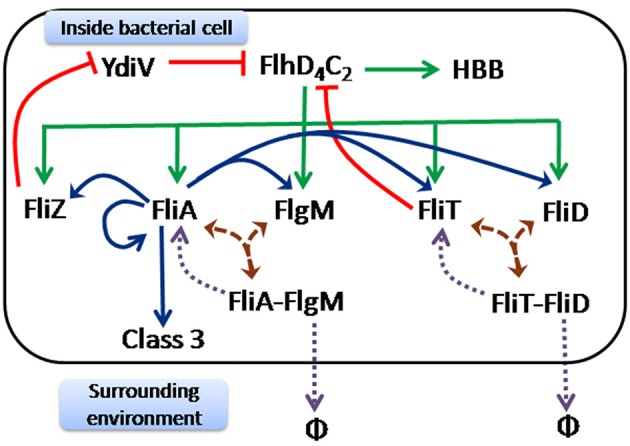Figure 1.

Regulatory network controlling expression of flagellar genes in S. typhimurium. The master regulator of flagella FlhD4C2 is at the top hierarchy of the regulatory cascade. Once it is expressed upon receiving multiple internal and external signals, a series of regulatory events take place for timely and proper expression of flagellar genes. The initial events have been represented by green arrows. These include activation of class 2 genes encoding HBB (hook, basal body) by FlhD4C2. At the same time, FlhD4C2 also activates the genes encoding five regulators—FliA (σ factor), FlgM (anti- σ factor), FliD (cap protein), FliT (anti- FlhD4C2 factor), and FliZ (regulator). The subsequent events have been depicted by brown arrows which include post-translational regulation through formation of two protein complexes FliA-FlgM (complex of FliA and FlgM) and FliT-FliD (complex of FliD and FliT). These complexes get disassociated only after complete assembly of HBB. The subsequent events after disassociation of these two protein complexes have been shown by purple dotted arrows. As the protein complexes get disrupted, FlgM and FliD are exported out of the cell (represented by φ), leaving free FliA and FliT inside the cell. Consequently, FliA carries out the next set of events represented by blue arrows. FliA activates class 3 genes encoding filament, motor and chemotaxis proteins. At the same time, FliA also activates itself and other class 2 genes encoding FliZ, FlgM, FliD and FliT. Finally, two feedback loops, represented by red edges, act on the master regulator FlhD4C2. These include FliZ dependent positive and FliT dependent negative feedback loops. FliZ acts as a repressor of a non-flagellar protein YdiV, which participates in nutritional status (of the cell) dependent regulation of FlhD4C2. FliT forms protein complex with FlhD4C2 and prevents FlhD4C2-dependent activation of class two genes.
